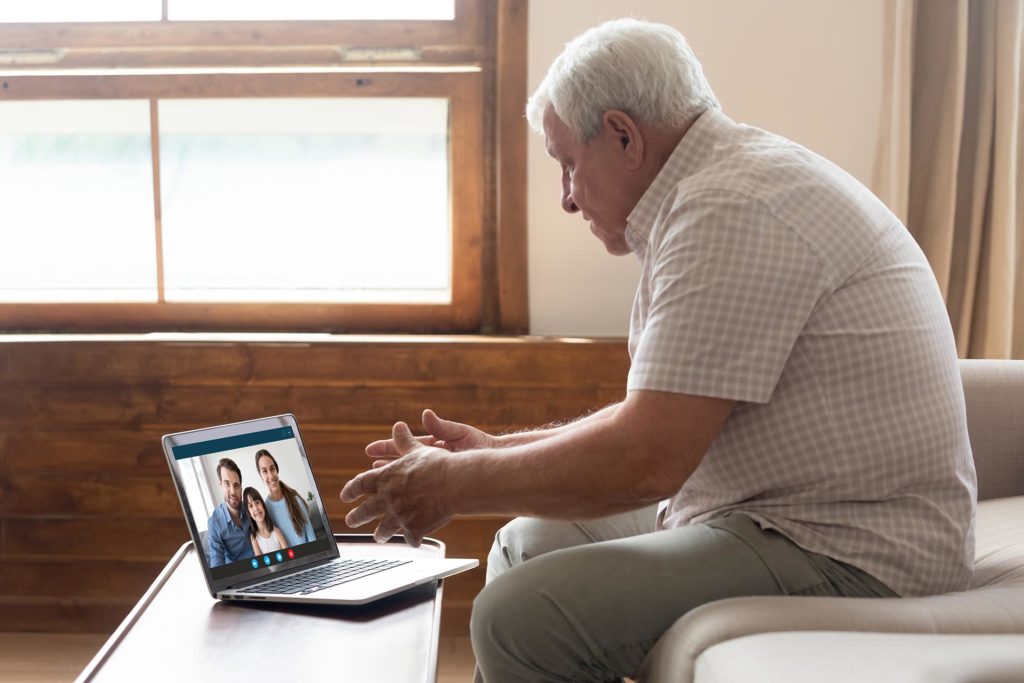The worldwide impact of implementation of unprecedented social distancing and limitations on social activities because of the COVID-19 pandemic may have helped control the spread of the disease but impacted older adults disproportionally. In a report from May of last year Hwang and colleagues noted: “…there is a high cost associated with the essential quarantine and social distancing interventions for COVID-19, especially in older adults, who have experienced an acute, severe sense of social isolation and loneliness with potentially serious mental and physical health consequences. The impact may be disproportionately amplified in those with pre-existing mental illness, who are often suffering from loneliness and social isolation prior to the enhanced distancing from others imposed by the COVID-19 pandemic public health measures. (Hwang et al, 2020)
Because many older adults are often dependent upon family members and community services for assistance with routine activities, social distancing should not equate to social disconnection. It is generally accepted that loneliness is the subjective feeling of being alone, and social isolation is a measurable assessment of individuals’ social contacts and interaction. Loneliness and isolation are not equal, but both can have a detrimental effect on health. Before the COVID-19 pandemic, Loneliness and isolation were found to be a “behavioral epidemic” across the USA, Europe and China (Jeste and colleagues, 2020.) The impact of COVID-19 social restrictions on top of the existing behavioral epidemic is impactful on many older adults, and especially so for individuals with pre-existing potential for mental illness. Loneliness has been found to be associated with increased risk for heart disease. Loneliness and social isolation have found to be factors in increased risk for coronary artery disease-associated death, even with younger individuals without prior history of heart disease (Heffner et al., 2011; Steptoe et al., 2013). Both loneliness and social isolation have been shown as independent risk factors for higher all-cause mortality (Yu et al., 2020).
In the face of these discouraging facts what can we do to prevent the detrimental effect of loneliness and social isolation? Hearing health care providers are in a unique position to spend more time with patients than their primary care physician or other health care providers. During interviews with individuals having trouble hearing, hearing care professionals may uncover symptoms that may not otherwise be discussed with a physician. There are several positive suggestions that are offered to patients and significant others that may help avoid loneliness and social isolation (Hwang et al, 2020):
- Keep family and friend connections. When routine visits are limited, telephone communication or Zoom and Skype connections can help sustain family and friend connections.
- Technology is a big help with social connections. Hearing aids today not only have the option for telecoils but have wireless connections with more Android and Apple devices than ever. If face-to-face communication is limited, difficulties may be solved by designing a good technological solution.
- Ensuring that basic needs such as food, medication, and telephone or tablet/computer availability is extremely important, especially for those who are living alone. Your hearing health care professional may help with outlining the best way to communicate your needs to others.
- Maintain a regular structured daily routine. Participation in activities that are pleasurable adds benefits for physical, mental, and spiritual well-being.
- Maintain activities that support physical and mental wellness. Today’s hearing aids can monitor movement and social engagement. Logging these parameters may serve as motivation for the user to seek out movement and engagement.
Hearing health care professionals are responsible for helping with devices and the techniques necessary for effective communication. As such, they are a resource for advice beyond the gadgets they provide. Please take advantage of their expertise and step into the world of better hearing!
References:
Hwang TJ, Rabheru K, Peisah C, Reichman W, Ikeda M. Loneliness and social isolation during the COVID-19 pandemic. Int Psychogeriatr. 2020;32(10):1217-1220. doi:10.1017/S1041610220000988
Jeste, D. V., Lee, E. E. and Cacioppo, S. (2020). Battling the Modern Behavioral Epidemic of Loneliness: Suggestions for Research and Interventions. JAMA Psychiatry. doi: 10.1001/jamapsychiatry.2020.0027
Heffner, K. L., Waring, M. E., Roberts, M. B., Eaton, C. B. and Gramling, R. (2011). Social isolation, C-reactive protein, and coronary heart disease mortality among community-dwelling adults. Social Science & Medicine, 72, 1482–1488.
Steptoe, A., Shankar, A., Demakakos, P. and Wardle, J. (2013). Social isolation, loneliness, and all-cause mortality in older men and women. Proceedings of the National Academy Sciences of the United States of America, 110, 5797–5801

